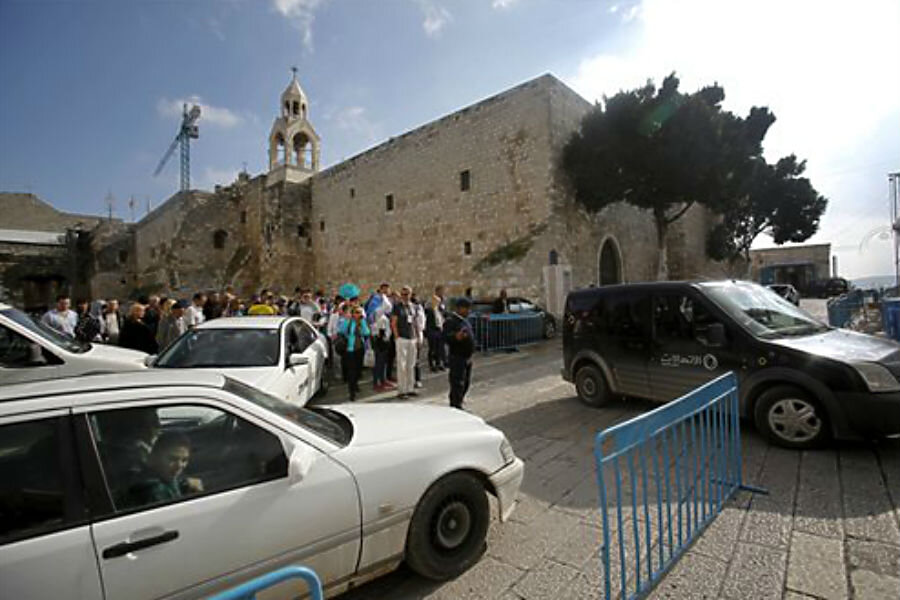Will a tunnel solve the little town of Bethlehem's big traffic problem?
Loading...
| Bethlehem, West Bank
It's Christmas season and the little town of Bethlehem is jammed with a big-city problem: Traffic snarling streets everywhere, including around the church marking the spot where tradition says Jesus was born. The city is considering a dramatic solution to the problem — digging a tunnel under Manger Square.
Traffic is a mess year-round. It may be the biblical town of grottos and shepherds' fields in the minds of many around the world, but Bethlehem is a modern densely populated town of 28,000 with a dizzying weave of small streets that practically guarantee traffic jams.
"Bethlehem is going through a crisis," said Anton Salman, a city councilor. "We think that the solution to this traffic is to build an underground passage between the two sides of the square."
Bethlehem's municipality hopes to eventually build several tunnels around the Palestinian city, where the urban development problems are myriad. Bethlehem is sandwiched on three sides by other towns. From the north and southeast, it is hemmed in by Israel's separation barrier and Jewish settlements, leaving it little choice but to build vertically.
It is also a main transit point for drivers between the northern and southern parts of the West Bank, compounding its congestion.
The area around the Nativity Church, built atop the site where Christians believe Jesus was born, is particularly busy, with a mix of tourists swarming the area and cars squeezing across the central Manger Square. Streets all around face a constant backlog because of traffic in the square, where beeping horns are heard as much as clanging church bells.
Even worse, during the holidays, the square is closed for annual events like the Christmas tree lighting and Christmas Eve celebrations, when it is thronged with revelers. That plunges traffic nearby deeper into chaos.
The plan proposes an 80-meter-long (260-foot long) tunnel passing under a narrow two-lane street that crosses Manger Square in front of the Nativity Church. The project would take about two years to complete and would cost $4 million to $5 million, with the Palestinian Authority pledging to foot the bill. If the plan is approved, construction could start next fall.
With the tunnel ensuring the flow of traffic, Manger Square would be closed to cars entirely under the plan and turned into a pedestrian expanse.
But the tunnel project could run aground before even breaking ground. The municipality would need to get a stamp of approval from the U.N.'s cultural agency UNESCO, which has listed the Nativity Church as a world heritage site and would want to ensure its protection. Junaid Sorosh-Wali, an official at UNESCO's Ramallah office, said the agency would study the plan once approached by Palestinian officials and then determine its position.
Also, because the tunnel would pass near church grounds, church officials from each of the three denominations that administer the site would need to be involved. Officials at the Roman Catholic, Greek Orthodox and Armenian churches did not return messages requesting comment.
And, as is always the case when excavating in the Holy Land, any significant archaeological finds could hamper progress on the project. To circumvent that, the study proposes digging a tunnel no deeper than 11 meters (33 feet). Anything of importance is usually buried further down, according to Mazen Karam, the director of the Bethlehem Development Foundation, a group that helped draft the tunnel study.
The city will also need to carve out a compensation plan for the businesses whose trade is disrupted by the tunnel construction.
For Karam, the tunnel is part of a series of projects meant to spruce up Bethlehem. His foundation has carried out work on cleaning up buildings in Manger Square and improving waste management in the city.
"If Joseph and Mary came back to Bethlehem, they would be shocked," he said. "Bethlehem doesn't deserve to be crowded with people and heavy traffic. It should be more open with wide spaces so people can go and enjoy the home of Jesus."
___
Follow Tia Goldenberg on Twitter at twitter.com/tgoldenberg







